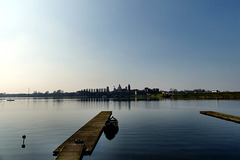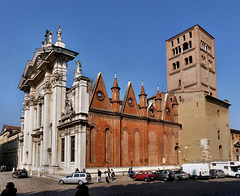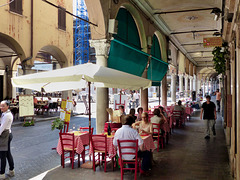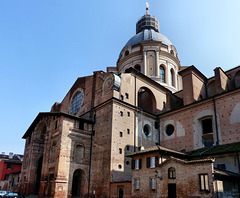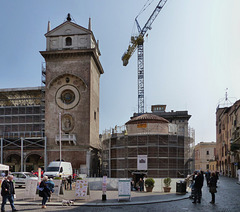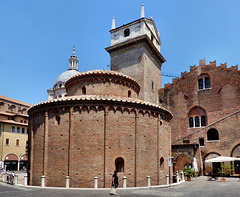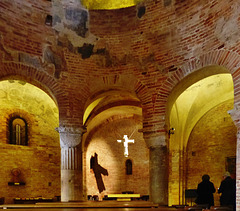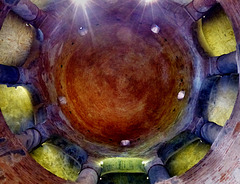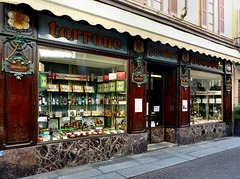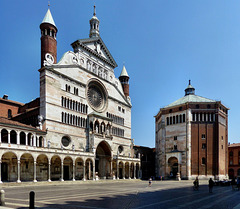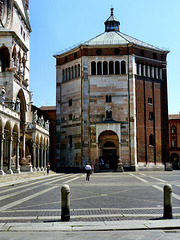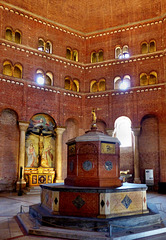
Lombardy / Lombardia
Old and new photos from various voyages..
Mantova
| |
|
|
Mantua (ital. Mantova) was a settlemt on the banks of River Mincio in Etruscan times. In Roman times veteran soldiers were placed here. About 70 BC the Roman poet Virgil (aka "Publius Vergilius Maro") was born nearby.
After the end of the Roman Empire Mantua was invaded in turn by Goths, Byzantines, Longobards, and Franks. In the 11th century, Mantua became a possession of Boniface of Canossa, marquis of Tuscany.
During the 12th century the course of the River Mincio was altered, creating lakes, to reinforce the city's natural protection. Three of these lakes still remain today.
Under the House of Gonzaga, that ruled Mantua for more than three centuries (sometimes in a very despotic way), the city developed and became a center of Renaissance art. At the end of the long war of the Mantuan Succession the city was under Austrian rule.
Mantua was part of the Napoleon's Kingdom of Italy. In 1810 Tyrolean innkeeper Andreas Hofer, the leader of the Tyrolean Rebellion against the French, was shot here by personal command of Napoleon.
Since 1948 the popular song "Zu Mantua in Banden" ("At Mantua bound"), dealing with the death of Andreas Hofer, is the official anthem of the Austrian State of Tyrol.
Seen here Mantua is seen over one of the existing lakes -
and here is the anthem
www.youtube.com/watch?v=ZsIU2hq-QIw
Mantova - Duomo di Mantova
| |
|
|
Mantua (ital. Mantova) was a settlemt on the banks of River Mincio in Etruscan times. In Roman times veteran soldiers were placed here. About 70 BC the Roman poet Virgil (aka "Publius Vergilius Maro") was born nearby.
After the end of the Roman Empire Mantua was invaded in turn by Goths, Byzantines, Longobards, and Franks. In the 11th century, Mantua became a possession of Boniface of Canossa, marquis of Tuscany.
During the 12th century the course of the River Mincio was altered, creating lakes, to reinforce the city's natural protection. Three of these lakes still remains today.
Under the House of Gonzaga, that ruled Mantua for more than three centuries (sometimes in a very despotic way), the city developed and became a center of Renaissance art. At the end of the long war of the Mantuan Succession the city was under Austrian rule.
Mantua was part of the Napoleon's Kingdom of Italy. Mantua returned to Austria in 1814. A revolt against the Austrians lasted from 1851 to 1855, but it was finally suppressed by the Austrian army. Finally in 1866 Mantua and the Lombardy were incorporated into the Kingdom of Italy.
Here is the "Duomo di Mantova", built in 1395–1401. The campanile is probably older, the Baroque facade was completed in 1761.
Mantova - Piazza Sordello
| |
|
|
Mantua (ital. Mantova) was a settlemt on the banks of River Mincio in Etruscan times. In Roman times veteran soldiers were placed here. About 70 BC the Roman poet Virgil (aka "Publius Vergilius Maro") was born nearby.
After the end of the Roman Empire Mantua was invaded in turn by Goths, Byzantines, Longobards, and Franks. In the 11th century, Mantua became a possession of Boniface of Canossa, marquis of Tuscany.
During the 12th century the course of the River Mincio was altered, creating lakes, to reinforce the city's natural protection. Three of these lakes still remains today.
Under the House of Gonzaga, that ruled Mantua for more than three centuries (sometimes in a very despotic way), the city developed and became a center of Renaissance art. At the end of the long war of the Mantuan Succession the city was under Austrian rule.
Mantua was part of the Napoleon's Kingdom of Italy. Mantua returned to Austria in 1814. Agitation against A revolt against the Austrians lasted from 1851 to 1855, but it was finally suppressed by the Austrian army. Finally in 1866 Mantua and the Lombardy were incorporated into the Kingdom of Italy.
Sunday market on the Piazza Sordello.
Seen here is on the right side of the piazza is the front of the huge Palazzo Ducale (350 rooms!), the former residence of the Gonzaga family. The white Baroque facade (and the campanile) of the "Duomo di Mantova" (see previous upload). The white building to the left is the" Palazzo Vescovile", the residence of the Bishop.
Mantova - Arcades
| |
|
|
|
Mantua (ital. Mantova) was a settlemt on the banks of River Mincio in Etruscan times. In Roman times veteran soldiers were placed here. About 70 BC the Roman poet Virgil (aka "Publius Vergilius Maro") was born nearby.
After the end of the Roman Empire Mantua was invaded in turn by Goths, Byzantines, Longobards, and Franks. In the 11th century, Mantua became a possession of Boniface of Canossa, marquis of Tuscany.
During the 12th century the course of the River Mincio was altered, creating lakes, to reinforce the city's natural protection. Three of these lakes still remains today.
Under the House of Gonzaga, that ruled Mantua for more than three centuries (sometimes in a very despotic way), the city developed and became a center of Renaissance art. At the end of the long war of the Mantuan Succession the city was under Austrian rule.
Mantua was part of the Napoleon's Kingdom of Italy. Mantua returned to Austria in 1814. Agitation against A revolt against the Austrians lasted from 1851 to 1855, but it was finally suppressed by the Austrian army. Finally in 1866 Mantua and the Lombardy were incorporated into the Kingdom of Italy.
Under the shady arcades, that connect the different piazzas, are numerous pavement cafes and restaurants.
Mantova - Basilica di Sant'Andrea
| |
|
Mantua (ital. Mantova) was a settlemt on the banks of River Mincio in Etruscan times. In Roman times veteran soldiers were placed here. About 70 BC the Roman poet Virgil (aka "Publius Vergilius Maro") was born nearby.
After the end of the Roman Empire Mantua was invaded in turn by Goths, Byzantines, Longobards, and Franks. In the 11th century, Mantua became a possession of Boniface of Canossa, marquis of Tuscany.
During the 12th century the course of the River Mincio was altered, creating lakes, to reinforce the city's natural protection. Three of these lakes still remains today.
Under the House of Gonzaga, that ruled Mantua for more than three centuries (sometimes in a very despotic way), the city developed and became a center of Renaissance art. At the end of the long war of the Mantuan Succession the city was under Austrian rule.
Mantua was part of the Napoleon's Kingdom of Italy. Mantua returned to Austria in 1814. Agitation against A revolt against the Austrians lasted from 1851 to 1855, but it was finally suppressed by the Austrian army. Finally in 1866 Mantua and the Lombardy were incorporated into the Kingdom of Italy.
The construction of the Basilica of Sant'Andrea, commissioned by Ludovico III Gonzaga, started in 1462 according to designs by Leon Battista Alberti, one of the "Renaissance Men" like Galileo and da Vinci being author, architect, poet, philosopher..
The building was finished only 328 years later. It houses a Holy Blood Relic ("Preziosissimo Sangue di Cristo"). The relic was "rediscovered" here within the 11th century connected to a legend, that told, that Roman centurion Longinus had brought it to Mantua. The body of Longinus was "rediscovered" in Mantua in 1304, together with the "Holy Sponge".
Mantova - Basilica di Sant'Andrea
| |
|
Mantua (ital. Mantova) was a settlemt on the banks of River Mincio in Etruscan times. In Roman times veteran soldiers were placed here. About 70 BC the Roman poet Virgil (aka "Publius Vergilius Maro") was born nearby.
After the end of the Roman Empire Mantua was invaded in turn by Goths, Byzantines, Longobards, and Franks. In the 11th century, Mantua became a possession of Boniface of Canossa, marquis of Tuscany.
During the 12th century the course of the River Mincio was altered, creating lakes, to reinforce the city's natural protection. Three of these lakes still remains today.
Under the House of Gonzaga, that ruled Mantua for more than three centuries (sometimes in a very despotic way), the city developed and became a center of Renaissance art. At the end of the long war of the Mantuan Succession the city was under Austrian rule.
Mantua was part of the Napoleon's Kingdom of Italy. Mantua returned to Austria in 1814. Agitation against A revolt against the Austrians lasted from 1851 to 1855, but it was finally suppressed by the Austrian army. Finally in 1866 Mantua and the Lombardy were incorporated into the Kingdom of Italy.
The construction of the Basilica of Sant'Andrea, commissioned by Ludovico III Gonzaga, started in 1462 according to designs by Leon Battista Alberti, one of the "Renaissance Men" like Galileo and da Vinci being author, architect, poet, philosopher..
The massive dome, seen here, was designed by Filippo Juvarra.
The building was finished only 328 years later. It houses a Holy Blood Relic ("Preziosissimo Sangue di Cristo"). The relic was "rediscovered" here within the 11th century connected to a legend, that told, that Roman centurion Longinus had brought it to Mantua.
Mantova - Rotonda di San Lorenzo
| |
|
Mantua (ital. Mantova) was a settlemt on the banks of River Mincio in Etruscan times. In Roman times veteran soldiers were placed here. About 70 BC the Roman poet Virgil (aka "Publius Vergilius Maro") was born nearby.
After the end of the Roman Empire Mantua was invaded in turn by Goths, Byzantines, Longobards, and Franks. In the 11th century, Mantua became a possession of Boniface of Canossa, marquis of Tuscany.
During the 12th century the course of the River Mincio was altered, creating lakes, to reinforce the city's natural protection. Three of these lakes still remains today.
Under the House of Gonzaga, that ruled Mantua for more than three centuries (sometimes in a very despotic way), the city developed and became a center of Renaissance art. At the end of the long war of the Mantuan Succession the city was under Austrian rule.
Mantua was part of the Napoleon's Kingdom of Italy, the city returned to Austria in 1814. A revolt against the Austrians was suppressed by the Austrian army in 1855. Finally in 1866 Mantua and the Lombardy were incorporated into the Kingdom of Italy.
The "Rotonda di San Lorenzo" is the oldest structure in Mantua, going back to the 11th century. This was the building I was most interested in in Mantua.
The rotunda was open for visitors, but, just like the neighbouring "Palazzo della Ragione", the church was hidden under a scaffolding.
I learned from a construction worker, that within the next weeks, the renovation of the round church would be completed. So I had to return to Mantua - later again.
Mantova - Rotonda di San Lorenzo
| |
|
Mantua (ital. Mantova) was a settlemt on the banks of River Mincio in Etruscan times. In Roman times veteran soldiers were placed here. About 70 BC the Roman poet Virgil (aka "Publius Vergilius Maro") was born nearby.
After the end of the Roman Empire Mantua was invaded in turn by Goths, Byzantines, Longobards, and Franks. In the 11th century, Mantua became a possession of Boniface of Canossa, marquis of Tuscany.
During the 12th century the course of the River Mincio was altered, creating lakes, to reinforce the city's natural protection. Three of these lakes still remains today.
Under the House of Gonzaga, that ruled Mantua for more than three centuries (sometimes in a very despotic way), the city developed and became a center of Renaissance art. At the end of the long war of the Mantuan Succession the city was under Austrian rule.
Mantua was part of the Napoleon's Kingdom of Italy, the city returned to Austria in 1814. A revolt against the Austrians was suppressed by the Austrian army in 1855. Finally in 1866 Mantua and the Lombardy were incorporated into the Kingdom of Italy.
The "Rotonda di San Lorenzo", here seen from the Piazza della Erbe, is the oldest structure in Mantua, going back to the 11th century. This was the building I was most interested in in Mantua.
The rotunda was open for visitors, but, just like the neighbouring "Palazzo della Ragione", the church was hidden under a scaffolding.
I learned from a construction worker, that within the next weeks, the renovation of the round church would be completed. So I had to return to Mantua - later again.
Mantova - Rotonda di San Lorenzo
| |
|
|
|
Mantua (ital. Mantova) was a settlemt on the banks of River Mincio in Etruscan times. In Roman times veteran soldiers were placed here. About 70 BC the Roman poet Virgil was born nearby.
After the end of the Roman Empire Mantua was invaded in turn by Goths, Byzantines, Longobards, and Franks. In the 11th century, Mantua became a possession of Boniface of Canossa, marquis of Tuscany.
During the 12th century the course of the River Mincio was altered, creating lakes, to reinforce the city's natural protection. Three of these lakes still remains today.
Under the House of Gonzaga, that ruled Mantua for more than three centuries (sometimes in a very despotic way), the city developed and became a center of Renaissance art. At the end of the long war of the Mantuan Succession the city was under Austrian rule.
Mantua was part of the Napoleon's Kingdom of Italy, the city returned to Austria in 1814. A revolt against the Austrians was suppressed by the Austrian army in 1855. Finally in 1866 Mantua and the Lombardy were incorporated into the Kingdom of Italy.
A year later (see previous upload) all scaffoldings were gone..
The "Rotonda di San Lorenzo" is the oldest structure in Mantua, going back to the 11th century. This was during the reign of the Canossa family, so the building is often connected to Matilda of Canossa (aka "Matilda of Tuscany"), a powerful supporter of Pope Gregory VII during the Investiture Controversy. But actually there is no proof.
The design is for sure inspired by the Holy Sepulchre church in Jerusalem.
The church fell in disrepair and got deconsecrated in 1579. The building was used
storage room, as well for dwellings and shops. About two centuries later, the church was completely forgotten but it got rediscovered end of the 19th century. 1909 - 1911 the building got reconstructed. All external additions got removed. As the roof was missing, designs from other rotundas in Northern Italy were studied - and so today the church looks perfect.
Mantova - Rotonda di San Lorenzo
| |
|
|
Mantua (ital. Mantova) was a settlemt on the banks of River Mincio in Etruscan times. In Roman times veteran soldiers were placed here. About 70 BC the Roman poet Virgil was born nearby.
After the end of the Roman Empire Mantua was invaded in turn by Goths, Byzantines, Longobards, and Franks. In the 11th century, Mantua became a possession of Boniface of Canossa, marquis of Tuscany.
During the 12th century the course of the River Mincio was altered, creating lakes, to reinforce the city's natural protection. Three of these lakes still remains today.
Under the House of Gonzaga, that ruled Mantua for more than three centuries (sometimes in a very despotic way), the city developed and became a center of Renaissance art. At the end of the long war of the Mantuan Succession the city was under Austrian rule.
Mantua was part of the Napoleon's Kingdom of Italy, the city returned to Austria in 1814. A revolt against the Austrians was suppressed by the Austrian army in 1855. Finally in 1866 Mantua and the Lombardy were incorporated into the Kingdom of Italy.
The "Rotonda di San Lorenzo" is the oldest structure in Mantua, going back to the 11th century. This was during the reign of the Canossa family, so the building is often connected to Matilda of Canossa (aka "Matilda of Tuscany"), a powerful supporter of Pope Gregory VII during the Investiture Controversy. But actually there is no proof.
The design is for sure inspired by the Holy Sepulchre church in Jerusalem.
The church fell in disrepair and got deconsecrated in 1579. It was used as a storage room, dwellings and shops. About two centuries later, the church was completely forgotten but got rediscovered end of the 19th century. 1909 - 1911 the building got reconstructed. All external additions got removed, so the brickwork, typical for lombardian architecture of the 11th century, van be seen. As the roof was missing, designs from other rotundas in Northern Italy were studied - and so today the church looks perfect.
Seen from this pov is, that the rotunda is "sunken" below the street level. A flight of stairs runs down to the entrance. The neighbouring "Palazzo della Ragione", only 2 centuries younger, is on the piazza´s street level. The reason may be, that the church was built on the round foundations of an ancient Roman temple, dedicated to Venus.
Mantova - Rotonda di San Lorenzo
| |
|
|
Mantua (ital. Mantova) was a settlemt on the banks of River Mincio in Etruscan times. In Roman times veteran soldiers were placed here. About 70 BC the Roman poet Virgil was born nearby.
After the end of the Roman Empire Mantua was invaded in turn by Goths, Byzantines, Longobards, and Franks. In the 11th century, Mantua became a possession of Boniface of Canossa, marquis of Tuscany.
During the 12th century the course of the River Mincio was altered, creating lakes, to reinforce the city's natural protection. Three of these lakes still remains today.
Under the House of Gonzaga, that ruled Mantua for more than three centuries (sometimes in a very despotic way), the city developed and became a center of Renaissance art. At the end of the long war of the Mantuan Succession the city was under Austrian rule.
Mantua was part of the Napoleon's Kingdom of Italy, the city returned to Austria in 1814. A revolt against the Austrians was suppressed by the Austrian army in 1855. Finally in 1866 Mantua and the Lombardy were incorporated into the Kingdom of Italy.
The "Rotonda di San Lorenzo" is the oldest structure in Mantua, going back to the 11th century. This was during the reign of the Canossa family, so the building is often connected to Matilda of Canossa (aka "Matilda of Tuscany"), a powerful supporter of Pope Gregory VII during the Investiture Controversy. But actually there is no proof.
The design is for sure inspired by the Holy Sepulchre church in Jerusalem.
The church fell in disrepair and got deconsecrated in 1579. It was used as a storage room, dwellings and shops. About two centuries later, the church was completely forgotten but got rediscovered end of the 19th century. 1909 - 1911 the building got reconstructed. All external additions got removed, so the brickwork, typical for lombardian architecture of the 11th century, van be seen. As the roof was missing, designs from other rotundas in Northern Italy were studied - and so today the church looks perfect.
The rotunda is "sunken" below the street level. A flight of stairs runs down to the entrance. The reason may be, that the church was built on the round foundations of an ancient Roman temple, dedicated to Venus.
Mantova - Rotonda di San Lorenzo
| |
|
|
Mantua (ital. Mantova) was a settlemt on the banks of River Mincio in Etruscan times. In Roman times veteran soldiers were placed here. About 70 BC the Roman poet Virgil was born nearby.
After the end of the Roman Empire Mantua was invaded in turn by Goths, Byzantines, Longobards, and Franks. In the 11th century, Mantua became a possession of Boniface of Canossa, marquis of Tuscany.
During the 12th century the course of the River Mincio was altered, creating lakes, to reinforce the city's natural protection. Three of these lakes still remains today.
Under the House of Gonzaga, that ruled Mantua for more than three centuries (sometimes in a very despotic way), the city developed and became a center of Renaissance art. At the end of the long war of the Mantuan Succession the city was under Austrian rule.
Mantua was part of the Napoleon's Kingdom of Italy, the city returned to Austria in 1814. A revolt against the Austrians was suppressed by the Austrian army in 1855. Finally in 1866 Mantua and the Lombardy were incorporated into the Kingdom of Italy.
The "Rotonda di San Lorenzo" is the oldest structure in Mantua, going back to the 11th century. This was during the reign of the Canossa family, so the building is often connected to Matilda of Canossa (aka "Matilda of Tuscany"), a powerful supporter of Pope Gregory VII during the Investiture Controversy. But actually there is no proof.
The design is for sure inspired by the Holy Sepulchre church in Jerusalem.
The church fell in disrepair and got deconsecrated in 1579. It was used as a storage room, dwellings and shops. About two centuries later, the church was completely forgotten but got rediscovered end of the 19th century. 1909 - 1911 the building got reconstructed. All external additions got removed, so the brickwork, typical for lombardian architecture of the 11th century, van be seen. As the roof was missing, designs from other rotundas in Northern Italy were studied - and so today the church looks perfect.
The rotunda is "sunken" below the street level. A flight of stairs runs down to the entrance. The reason may be, that the church was built on the round foundations of an ancient Roman temple, dedicated to Venus.
The two pillars seen here are spolia, they are reused Roman works. Traces of frescoes can still be seen up on the walls.
Mantova - Rotonda di San Lorenzo
| |
|
|
Mantua (ital. Mantova) was a settlemt on the banks of River Mincio in Etruscan times. In Roman times veteran soldiers were placed here. About 70 BC the Roman poet Virgil was born nearby.
After the end of the Roman Empire Mantua was invaded in turn by Goths, Byzantines, Longobards, and Franks. In the 11th century, Mantua became a possession of Boniface of Canossa, marquis of Tuscany.
During the 12th century the course of the River Mincio was altered, creating lakes, to reinforce the city's natural protection. Three of these lakes still remains today.
Under the House of Gonzaga, that ruled Mantua for more than three centuries (sometimes in a very despotic way), the city developed and became a center of Renaissance art. At the end of the long war of the Mantuan Succession the city was under Austrian rule.
Mantua was part of the Napoleon's Kingdom of Italy, the city returned to Austria in 1814. A revolt against the Austrians was suppressed by the Austrian army in 1855. Finally in 1866 Mantua and the Lombardy were incorporated into the Kingdom of Italy.
The "Rotonda di San Lorenzo" is the oldest structure in Mantua, going back to the 11th century. This was during the reign of the Canossa family, so the building is often connected to Matilda of Canossa (aka "Matilda of Tuscany"), a powerful supporter of Pope Gregory VII during the Investiture Controversy. But actually there is no proof.
The design is for sure inspired by the Holy Sepulchre church in Jerusalem.
The church fell in disrepair and got deconsecrated in 1579. It was used as a storage room, dwellings and shops. About two centuries later, the church was completely forgotten but got rediscovered end of the 19th century. 1909 - 1911 the building got reconstructed. All external additions got removed, so the brickwork, typical for lombardian architecture of the 11th century, van be seen. As the roof was missing, designs from other rotundas in Northern Italy were studied - and so today the church looks perfect.
The rotunda is "sunken" below the street level. A flight of stairs runs down to the entrance. The reason may be, that the church was built on the round foundations of an ancient Roman temple, dedicated to Venus.
Cremona - Sperlari
| |
|
|
|
The Sperlari chocolate shop was founded in Cremona in 1836. Sperlari sweets are sold all over Italy. They are not produced in the center of the city, but in a factory in the outskirts of Cremona.
www.sperlari.it/
Cremona - Baptistery
| |
|
|
|
The construction of the octogonal "Cremona Baptistery" next to the Cathedral started in 1167. At that time the cathedral was not completed. The baptistery measures 34 meters in height and 20.50 meters in diameter.
During the time of the Renaissance some alterations were done. One was to cover the bare brick walls with white marble. This was started, but never completed.
This is probably the piazza, where in 1237 and 1241 the "Cremona elephant" (see previous uploads) could be seen in Frederick II´s triumph parades. The piazza is lined by the baptistery, the duomo, Torrazzo, the massive tower on one side and the Palazzo Comunale and the Loggia dei Militi on the other.
Cremona - Baptistery
| |
|
|
|
The construction of the octogonal "Cremona Baptistery" next to the Cathedral started in 1167. At that time the cathedral was not completed. The baptistery measures 34 meters in height and 20.50 meters in diameter.
During the time of the Renaissance some alterations were done. One was to cover the bare brick walls with white marble. This was started, but never completed.
Cremona - Baptistery
| |
|
|
|
The construction of the octogonal "Cremona Baptistery" next to the Cathedral started in 1167. At that time the cathedral was not completed. The baptistery measures 34 meters in height and 20.50 meters in diameter.
During the time of the Renaissance some alterations were done. The octogonal baptismal font seen here was added within the 16th century.
Cremona - Baptistery
| |
|
The construction of the octogonal "Cremona Baptistery" next to the Cathedral started in 1167. At that time the cathedral was not completed. The baptistery measures 34 meters in height and 20.50 meters in diameter.
During the time of the Renaissance some alterations were done. The octogonal baptismal font in the center of the baptistery was added within the 16th century.
This much older font is displayed in the baptistery. It may have been used somehwere else.
Jump to top
RSS feed- Latest items - Subscribe to the latest items added to this album
- ipernity © 2007-2024
- Help & Contact
|
Club news
|
About ipernity
|
History |
ipernity Club & Prices |
Guide of good conduct
Donate | Group guidelines | Privacy policy | Terms of use | Statutes | In memoria -
Facebook
Twitter

